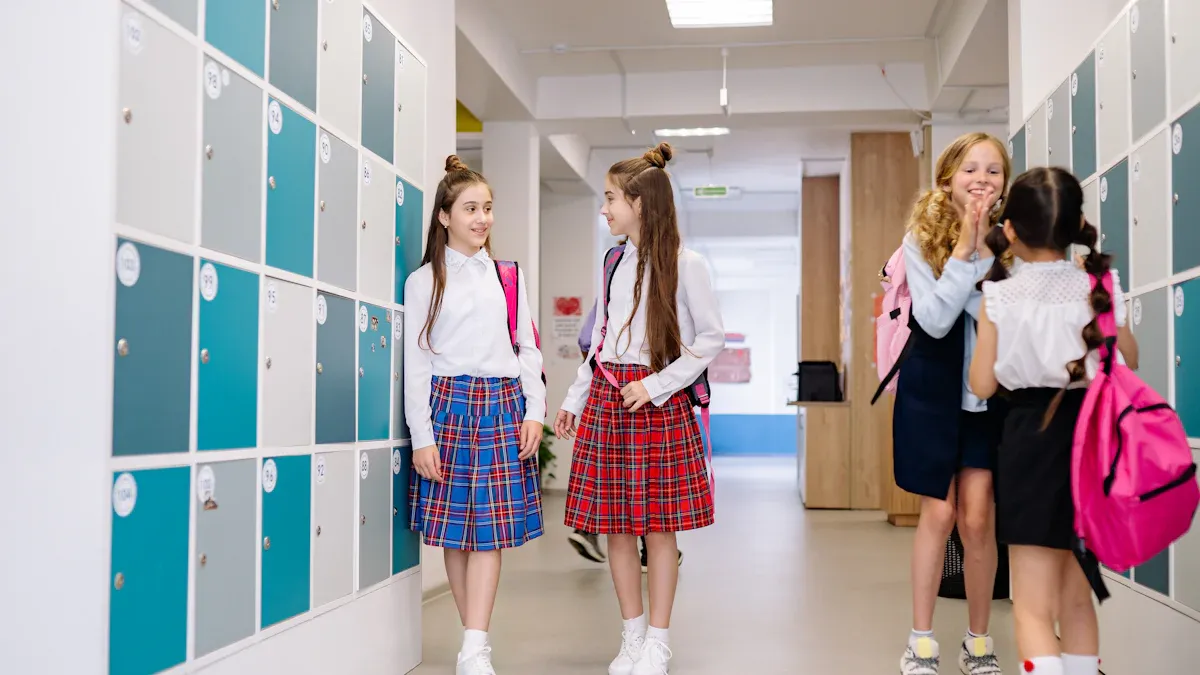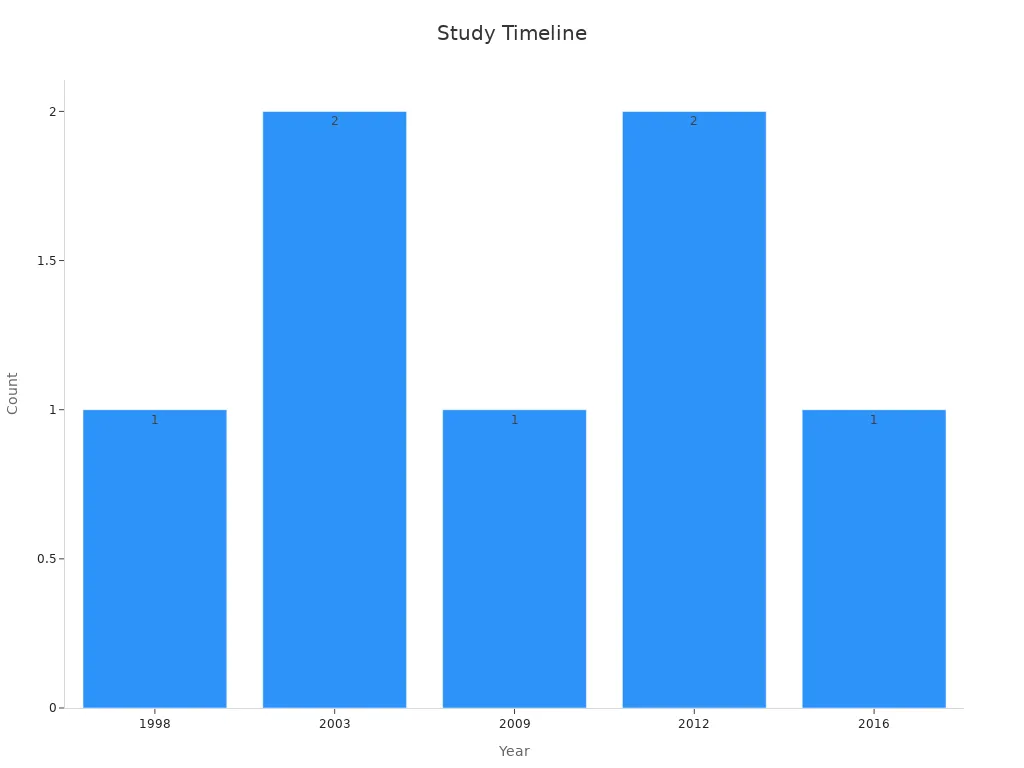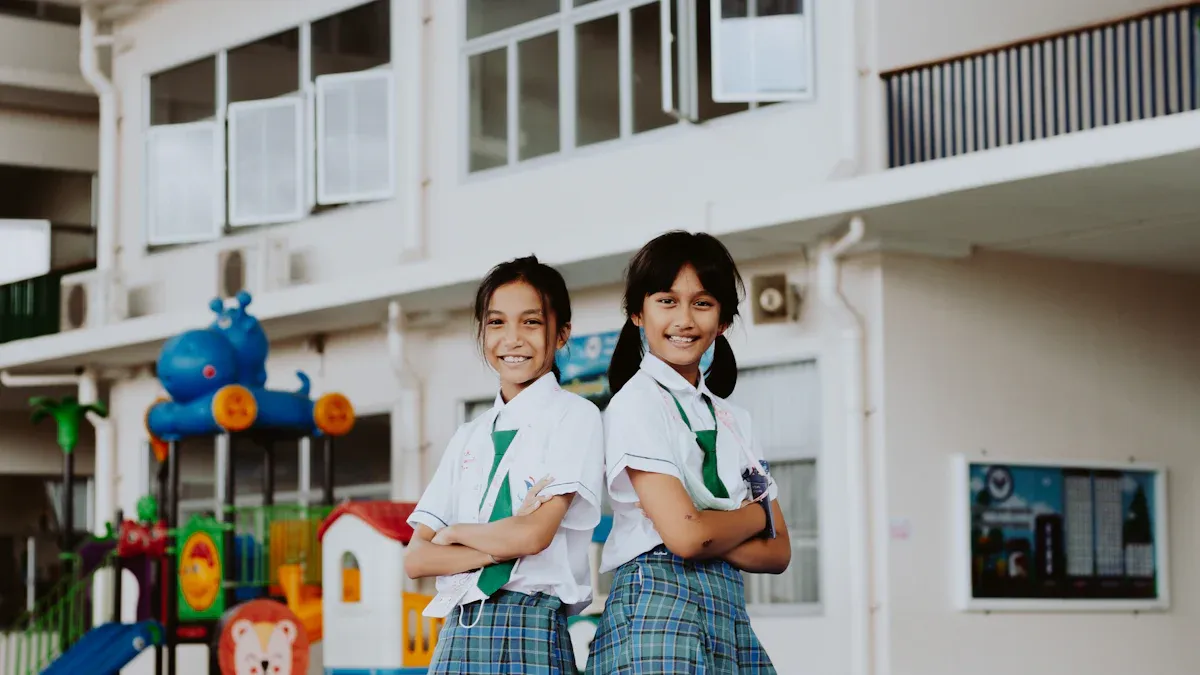
Classic school uniform patterns, such as the British-style check school uniform fabric, are evolving to reflect modern values. Schools now embrace sustainable materials like polyester viscose fabric and organic cotton. This shift aligns with rising global education rates and the demand for custom check school uniform fabric that balances individuality with tradition. Additionally, the use of school uniform check fabric is becoming more popular, including options like college-style check school uniform fabric, which cater to diverse student preferences.
Key Takeaways
- Today’s school uniforms use green materials like organic cotton and recycled fabrics. This helps protect the environment and supports sustainability.
- Schools now have gender-neutral styles. These designs make all students feel included and at ease in their uniforms.
- Personal touches matter; students can show their unique style while following uniform rules. This mixes personal fashion with school pride.
The Legacy of Classic School Uniform Patterns
Iconic Patterns: Plaids, Checks, and Stripes
Plaids, checks, and stripes have long defined the aesthetic of school uniforms. These patterns, rooted in tradition, symbolize structure and order. Plaids, for instance, often evoke a sense of heritage, with many designs inspired by Scottish tartans. Checks, on the other hand, offer a more versatile and modern appeal, while stripes convey a sense of formality and hierarchy. I’ve noticed that these patterns not only serve as visual identifiers but also create a sense of unity among students. Their timeless appeal ensures they remain a staple in school uniform fabric design.
Historical Role of Uniforms in Education
The history of school uniforms dates back centuries. In 1222, the Archbishop of Canterbury mandated the cappa clausa, marking the first recorded use of standardized academic dress. By 1552, Christ’s Hospital introduced its iconic blue coats and yellow stockings, a uniform still worn today. These milestones highlight how uniforms have evolved to reflect societal values.
| Year | Event Description |
|---|---|
| 1222 | The Archbishop of Canterbury’s order for the cappa clausa represents the earliest known instance of a school uniform. |
| 1552 | The introduction of the blue cloaks and yellow stockings at Christ’s Hospital marks a significant development in school uniform history. |
Uniforms have since become a symbol of equality, ensuring that students focus on learning rather than attire. Over time, their role has expanded to include fostering school pride and creating a cohesive educational environment.
Uniforms as Symbols of Identity and Discipline
Uniforms play a crucial role in shaping student identity and promoting discipline. Studies, such as the one by Baumann and Krskova (2016), reveal that uniforms correlate with better listening and reduced noise levels in classrooms. They also symbolize a commitment to academic values and community standards. I’ve observed that wearing a uniform often instills a sense of belonging and responsibility in students. While some argue that uniforms limit self-expression, their benefits in fostering discipline and unity cannot be overlooked.

Modern Reinterpretations in Design and Fashion

School Uniform Fabric: Innovations in Material Choices
I’ve noticed that modern school uniforms are embracing innovative materials to meet the demands of today’s students and parents. Schools now prioritize fabrics that combine comfort, durability, and functionality. For instance, many institutions are adopting blends like polyester viscose fabric, which offers a balance of softness and resilience. Additionally, eco-friendly materials such as organic cotton and recycled fibers are gaining popularity.
- The global school uniform market reflects these changes:
- Customizable designs allow students to express individuality within uniform guidelines.
- Eco-friendly materials address growing environmental concerns.
- Technology integration, such as RFID tags, enhances convenience and security.
These advancements in school uniform fabric demonstrate how schools are aligning with modern values while maintaining practicality.
Gender-Neutral and Inclusive Designs
Inclusivity has become a cornerstone of modern uniform design. I’ve observed a growing trend toward gender-neutral options that cater to all students, regardless of gender identity. These designs often feature unisex cuts, adjustable fits, and neutral color palettes. By offering such choices, schools foster an environment of equality and respect. This shift not only reflects societal progress but also ensures that every student feels comfortable and represented in their attire.
Sustainable and Ethical Production Practices
Sustainability is no longer optional in school uniform production. Many manufacturers now focus on ethical practices to minimize environmental impact. For example, the use of recycled fibers and bio-based polymers has become standard in eco-friendly production. Schools also collaborate with suppliers who follow green sourcing methods.
| Evidence Type | Description |
|---|---|
| Eco-friendly materials | Use of recycled fibers, bio-based polymers, and eco-friendly dyes to minimize environmental impact. |
| Sustainable sourcing | Collaboration with suppliers who follow green production methods to enhance sustainability. |
| Technological innovations | Adoption of new technologies that contribute to sustainable practices in uniform production. |
These efforts ensure that school uniform fabric not only meets functional needs but also aligns with ethical and environmental standards.
Cultural and Societal Influences Driving Change
The Push for Individuality in Uniform Design
I’ve noticed a growing demand for individuality in school uniform design. Students increasingly seek ways to express their personalities, even within the constraints of standardized attire. Surveys reveal that many students dislike traditional uniforms, though some acknowledge their benefits, such as fostering better treatment by peers. Interestingly, more females than males report positive social experiences when wearing uniforms, while fewer females face detentions for uniform violations. These findings highlight the nuanced relationship between individuality and conformity in school settings.
To address this, schools are exploring customizable options that allow students to personalize their uniforms without compromising the sense of unity. This shift reflects a broader societal trend toward valuing self-expression and inclusivity.
The Role of Pop Culture and Media in Shaping Trends
Pop culture and media play a significant role in redefining school uniform trends. I’ve observed how movies, TV shows, and social media platforms influence students’ perceptions of what uniforms should look like. For example, Japan’s schoolgirls have set global trends with their stylish adaptations of traditional uniforms. Studies, such as those by Craik (2007) and Freeman (2017), discuss how uniforms in popular culture serve as markers of identity and change.
| Source | Description |
|---|---|
| Craik, J. (2007) | Explores uniforms as symbols of identity in pop culture. |
| Freeman, Hadley (2017) | Examines how societal trends, like sexism, influence uniform rules. |
| APA Task Force (2007) | Links media-driven trends to the sexualization of girls in uniforms. |
| Independent (1997) | Highlights Japan’s influence on global uniform styles. |
These influences often challenge traditional designs, pushing schools to adapt to modern aesthetics while maintaining their core values.
Globalization and Cross-Cultural Design Influences
Globalization has blurred cultural boundaries, leading to cross-cultural influences in school uniform design. I’ve seen how uniforms now incorporate elements from diverse traditions, reflecting the interconnectedness of today’s world. In Asia and Europe, uniforms often symbolize cultural identity and societal norms. For instance, school uniform fabric choices in these regions frequently align with local traditions.
Educational reforms and rising school enrollments further drive the demand for standardized uniforms. However, the evolving fashion landscape presents challenges. Students increasingly prefer modern, customizable designs that reflect global trends. This dynamic interplay between tradition and innovation underscores the impact of globalization on school uniforms.
Examples of Modern Adaptations in Schools and Beyond

Schools Adopting Contemporary Uniform Styles
I’ve observed that schools are increasingly adopting contemporary uniform styles to reflect modern values and cultural diversity. Historically, uniforms symbolized discipline and equality. Today, they blend traditional and modern elements, showcasing a variety of styles and materials. For instance, many schools now incorporate sustainable fabrics into their designs, such as organic cotton or recycled polyester. This shift not only caters to environmentally conscious students but also aligns with the evolving fashion landscape.
Modern skirt designs, for example, highlight this transformation. They combine innovative styles with sustainable materials, appealing to students who value both fashion and functionality. Additionally, schools prioritize comfort and practicality, ensuring that uniforms meet institutional standards while embracing cultural identity. These changes demonstrate how schools are redefining uniforms to balance tradition with contemporary needs.
Uniform-Inspired Streetwear and Everyday Fashion
Uniform-inspired streetwear has gained significant traction in recent years. I’ve noticed how classic patterns like plaids and checks have transitioned from classrooms to everyday fashion. This trend reflects the growing influence of school uniform fabric in mainstream clothing. Analysts predict a compound annual growth rate of 7–9% for the uniform textiles market over the next decade. This growth stems from advancements in textile technology and the rising demand for customization.
Sustainability also plays a key role in this trend. Manufacturers focusing on eco-friendly production methods are gaining a competitive edge. Their efforts align with consumer preferences for environmentally conscious fashion, further fueling the popularity of uniform-inspired streetwear. These developments highlight how traditional designs continue to shape modern fashion trends.
Designer Collaborations with Educational Institutions
Collaborations between designers and schools have revolutionized uniform design. I’ve seen how these partnerships introduce fresh perspectives while maintaining the essence of school attire. Designers often incorporate innovative materials and contemporary aesthetics, creating uniforms that resonate with students. For example, some collaborations feature limited-edition collections that blend functionality with high fashion.
These partnerships also emphasize sustainability. Designers work with schools to source eco-friendly materials and adopt ethical production practices. This approach not only enhances the appeal of uniforms but also reinforces the importance of environmental responsibility. By collaborating with designers, schools can offer students attire that reflects both modern trends and institutional values.
The Future of School Uniform Patterns
Emerging Trends in School Uniform Fabric and Design
I’ve noticed that the school uniform market is evolving rapidly, driven by urbanization and rising disposable incomes in emerging economies. Schools are now prioritizing quality and innovation in their designs. Customization has become a key focus, allowing institutions to reflect their identity while giving students a sense of individuality. Sustainable practices are also gaining traction, with manufacturers increasingly using eco-friendly materials like organic cotton and recycled polyester.
| Trend/Innovation | Description |
|---|---|
| Technological Innovations | Advances in nanotechnology, 3D printing, and AI-driven automation for lighter, smarter uniforms. |
| Customization | Digital printing and interactive design platforms for rapid customization of uniforms. |
| Sustainability | Use of eco-friendly materials and production methods to reduce environmental impact. |
These trends highlight how schools are balancing tradition with modern demands, ensuring that school uniform fabric meets both functional and ethical standards.
Balancing Tradition with Innovation
Balancing tradition with innovation remains a challenge for schools. I’ve observed that many institutions aim to preserve the classic appeal of uniforms while embracing modern values. For example, traditional patterns like plaids and checks are now being reimagined with sustainable fabrics and contemporary cuts. This approach ensures that uniforms remain timeless yet relevant. Schools are also exploring ways to incorporate cultural elements into designs, reflecting their unique heritage while staying aligned with global trends.
The Role of Technology in Customizing Uniforms
Technology is revolutionizing school uniforms. I’ve seen how advancements like digital printing and interactive design platforms allow schools to create unique, customizable uniforms efficiently. Smart fabrics are also making their way into the market. These include uniforms embedded with RFID tags and GPS trackers, enhancing safety and convenience. As technology continues to evolve, I believe it will play an even greater role in shaping the future of school uniform fabric, offering endless possibilities for personalization and functionality.
Classic school uniform patterns now reflect modern values. I’ve seen how they balance tradition with innovation, driven by cultural shifts and technological advancements.
The future lies in creating designs that are inclusive, sustainable, and adaptable. Schools must embrace these changes to meet evolving societal needs while preserving the essence of their identity.
FAQ
What makes modern school uniforms different from traditional ones?
Modern uniforms prioritize inclusivity, sustainability, and individuality. Schools now use eco-friendly fabrics, gender-neutral designs, and customizable options to reflect evolving societal values.
How do schools balance tradition with innovation in uniform design?
Schools retain classic patterns like plaids and checks while integrating sustainable materials and contemporary cuts. This approach preserves heritage while meeting modern expectations.
Are school uniforms becoming more sustainable?
Yes, many schools now adopt eco-friendly practices. Manufacturers use recycled fibers, organic cotton, and ethical production methods to reduce environmental impact and promote sustainability.
Tip: Look for uniforms labeled with certifications like GOTS (Global Organic Textile Standard) to ensure they meet sustainability standards.
Post time: Mar-24-2025
